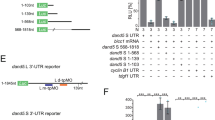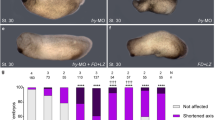Abstract
Defining the three body axes is a central event of vertebrate morphogenesis. Establishment of left–right (L–R) asymmetry in development follows the determination of dorsal–ventral and anterior–posterior (A–P) body axes1,2, although the molecular mechanism underlying precise L–R symmetry breaking in reference to the other two axes is still poorly understood. Here, by removing both Vangl1 and Vangl2, the two mouse homologues of a Drosophila core planar cell polarity (PCP) gene Van Gogh (Vang), we reveal a previously unrecognized function of PCP in the initial breaking of lateral symmetry. The leftward nodal flow across the posterior notochord (PNC) has been identified as the earliest event in the de novo formation of L–R asymmetry3,4. We show that PCP is essential in interpreting the A–P patterning information and linking it to L–R asymmetry. In the absence of Vangl1 and Vangl2, cilia are positioned randomly around the centre of the PNC cells and nodal flow is turbulent, which results in disrupted L–R asymmetry. PCP in mouse, unlike what has been implicated in other vertebrate species, is not required for ciliogenesis, cilium motility, Sonic hedgehog (Shh) signalling or apical docking of basal bodies in ciliated tracheal epithelial cells. Our data suggest that PCP acts earlier than the unidirectional nodal flow during bilateral symmetry breaking in vertebrates and provide insight into the functional mechanism of PCP in organizing the vertebrate tissues in development.
This is a preview of subscription content, access via your institution
Access options
Subscribe to this journal
Receive 51 print issues and online access
$199.00 per year
only $3.90 per issue
Buy this article
- Purchase on Springer Link
- Instant access to full article PDF
Prices may be subject to local taxes which are calculated during checkout




Similar content being viewed by others
References
Wilhelmi, H. Experimentelle Untersuchungen über situs inversus viscerum. Arch. EntwMech. 48, 517–532 (1921)
Brown, N. A. & Wolpert, L. The development of handedness in left/right asymmetry. Development 109, 1–9 (1990)
Nonaka, S. et al. Randomization of left–right asymmetry due to loss of nodal cilia generating leftward flow of extraembryonic fluid in mice lacking KIF3B motor protein. Cell 95, 829–837 (1998)
Blum, M. et al. Ciliation and gene expression distinguish between node and posterior notochord in the mammalian embryo. Differentiation 75, 133–146 (2007)
Nonaka, S. et al. De novo formation of left–right asymmetry by posterior tilt of nodal cilia. PLoS Biol. 3, e268 (2005)
Okada, Y., Takeda, S., Tanaka, Y., Belmonte, J. C. & Hirokawa, N. Mechanism of nodal flow: a conserved symmetry breaking event in left–right axis determination. Cell 121, 633–644 (2005)
Seifert, J. R. & Mlodzik, M. Frizzled/PCP signalling: a conserved mechanism regulating cell polarity and directed motility. Nature Rev. Genet. 8, 126–138 (2007)
Axelrod, J. D. & McNeill, H. Coupling planar cell polarity signaling to morphogenesis. ScientificWorldJournal 2, 434–454 (2002)
Jessen, J. R. et al. Zebrafish trilobite identifies new roles for Strabismus in gastrulation and neuronal movements. Nature Cell Biol. 4, 610–615 (2002)
Hamada, H., Meno, C., Watanabe, D. & Saijoh, Y. Establishment of vertebrate left–right asymmetry. Nature Rev. Genet. 3, 103–113 (2002)
Lowe, L. A. et al. Conserved left–right asymmetry of nodal expression and alterations in murine situs inversus. Nature 381, 158–161 (1996)
Collignon, J., Varlet, I. & Robertson, E. J. Relationship between asymmetric nodal expression and the direction of embryonic turning. Nature 381, 155–158 (1996)
Nakamura, T. et al. Generation of robust left–right asymmetry in the mouse embryo requires a self-enhancement and lateral-inhibition system. Dev. Cell 11, 495–504 (2006)
Meno, C. et al. lefty-1 is required for left–right determination as a regulator of lefty-2 and nodal. Cell 94, 287–297 (1998)
Yoshioka, H. et al. Pitx2, a bicoid-type homeobox gene, is involved in a Lefty-signaling pathway in determination of left-right asymmetry. Cell 94, 299–305 (1998)
Lawrence, P. A., Struhl, G. & Casal, J. Planar cell polarity: one or two pathways? Nature Rev. Genet. 8, 555–563 (2007)
Park, T. J., Haigo, S. L. & Wallingford, J. B. Ciliogenesis defects in embryos lacking inturned or fuzzy function are associated with failure of planar cell polarity and Hedgehog signaling. Nature Genet. 38, 303–311 (2006)
Poole, C. A., Flint, M. H. & Beaumont, B. W. Analysis of the morphology and function of primary cilia in connective tissues: a cellular cybernetic probe? Cell Motil. 5, 175–193 (1985)
Lee, J. D. & Anderson, K. V. Morphogenesis of the node and notochord: the cellular basis for the establishment and maintenance of left–right asymmetry in the mouse. Dev. Dyn. 237, 3464–3476 (2008)
Jones, C. et al. Ciliary proteins link basal body polarization to planar cell polarity regulation. Nature Genet. 40, 69–77 (2008)
McGrath, J., Somlo, S., Makova, S., Tian, X. & Brueckner, M. Two populations of node monocilia initiate left–right asymmetry in the mouse. Cell 114, 61–73 (2003)
Tabin, C. J. The key to left–right asymmetry. Cell 127, 27–32 (2006)
Gros, J., Feistel, K., Viebahn, C., Blum, M. & Tabin, C. J. Cell movements at Hensen's node establish left/right asymmetric gene expression in the chick. Science 324, 941–944 (2009)
Kishimoto, N., Cao, Y., Park, A. & Sun, Z. Cystic kidney gene seahorse regulates cilia-mediated processes and Wnt pathways. Dev. Cell 14, 954–961 (2008)
Maisonneuve, C. et al. Bicaudal C, a novel regulator of Dvl signaling abutting RNA-processing bodies, controls cilia orientation and leftward flow. Development 136, 3019–3030 (2009)
Simons, M. et al. Inversin, the gene product mutated in nephronophthisis type II, functions as a molecular switch between Wnt signaling pathways. Nature Genet. 37, 537–543 (2005)
Hashimoto, M. et al. Planar polarization of node cells determines the rotational axis of node cilia. Nature Cell Biol. 12, 170–176 (2010)
Sharma, N., Berbari, N. F. & Yoder, B. K. Ciliary dysfunction in developmental abnormalities and diseases. Curr. Top. Dev. Biol. 85, 371–427 (2008)
Guirao, B. et al. Coupling between hydrodynamic forces and planar cell polarity orients mammalian motile cilia. Nature Cell Biol. 12, 341–350 (2010)
Borovina, A., Superina, S., Voskas, D. & Ciruna, B. Vangl2 directs the posterior tilting and asymmetric localization of motile primary cilia. Nature Cell Biol. 12, 407–412 (2010)
Hayashi, S., Tenzen, T. & McMahon, A. P. Maternal inheritance of Cre activity in a Sox2Cre deleter strain. Genesis 37, 51–53 (2003)
Topol, L. et al. Wnt-5a inhibits the canonical Wnt pathway by promoting GSK-3-independent β-catenin degradation. J. Cell Biol. 162, 899–908 (2003)
Acknowledgements
We thank members of the Yang laboratory for stimulating discussion; M. Kuehn, A. Kumar and J. Regard for critical reading of the manuscript; J. Fekecs and D. Leja for preparing the graphics; D. Wu for teaching us to dissect the mouse cochlea; and M. Kelley for the anti-Vangl2 antibodies. This study is supported by the intramural research programme of National Human Genome Research Institute.
Author information
Authors and Affiliations
Contributions
H.S. designed and performed the experiments, generated most of the data in the manuscript, and interpreted and presented the data in figures. J.H. designed and performed some of the experiments, conducted statistical analysis, interpreted the data and put it together in figures. W.C. analysed and maintained the Vangl1 mutant mice. G.E. generated the Vangl1 and Vangl2 mutant mice by performing blastocyst injection and tetraploid aggregation. P.A. and B.G. provided some critical technical support and help in writing the manuscript. Y.Y. designed and supervised the entire project, interpreted all data and wrote the manuscript.
Corresponding author
Ethics declarations
Competing interests
The authors declare no competing financial interests.
Supplementary information
Supplementary Figures
This file contains Supplementary Figures S1-S7 with legends. (PDF 7259 kb)
Supplementary Movie 1
This movie shows the smooth nodal flow indicated by unidirectional bead movement in a control embryo. The nodal flow was visualized by latex beads in a Vangl2Δ/+;Vangl1gt/+ embryo at E8.0. The time lapse covers a period of about 13 seconds. Movie was acquired at 14 frames per second (fps) and is played back at the same speed. By following the bead movement and tracing the paths with lines in different color, it is evident from the straight and parallel bead paths that the nodal flow in the control embryo is smooth and unidirectional (leftward). (MOV 2918 kb)
Supplementary Movie 2
This movie shows the turbulent nodal flow indicated by abnormal bead movement in aVangl2Δ/Δ;Vangl1gt/gt embryo at E8.0. The movie was taken as described above. It is evident that the unidirectional leftward nodal flow is disrupted as the bead paths contained "knots", abrupt turns and were often crossed with each other. (MOV 3126 kb)
Supplementary Movie 3
This movie shows the beating cilia in the PNC of a control (Vangl2Δ/+; Vangl1gt/+) embryo at E8.0. The time lapse covers a period of about 12 seconds. The movie was acquired at 42 fps and is played back at 10 fps. (MOV 588 kb)
Supplementary Movie 4
This movie shows the beating cilia in the PNC of a Vangl2Δ/Δ;Vangl1gt/gt embryo at E8.0. The cilia in the mutant PNC were beating in the same direction and at the same speed as in the control embryos. (MOV 491 kb)
Rights and permissions
About this article
Cite this article
Song, H., Hu, J., Chen, W. et al. Planar cell polarity breaks bilateral symmetry by controlling ciliary positioning. Nature 466, 378–382 (2010). https://doi.org/10.1038/nature09129
Received:
Accepted:
Published:
Issue Date:
DOI: https://doi.org/10.1038/nature09129
This article is cited by
-
Role of the Ror family receptors in Wnt5a signaling
In Vitro Cellular & Developmental Biology - Animal (2024)
-
Single cell RNA analysis of the left–right organizer transcriptome reveals potential novel heterotaxy genes
Scientific Reports (2023)
-
Mechanical regulation of early vertebrate embryogenesis
Nature Reviews Molecular Cell Biology (2022)
-
Vangl2 participates in the primary ciliary assembly under low fluid shear stress in hUVECs
Cell and Tissue Research (2022)
-
Wnt/planar cell polarity signaling controls morphogenetic movements of gastrulation and neural tube closure
Cellular and Molecular Life Sciences (2022)
Comments
By submitting a comment you agree to abide by our Terms and Community Guidelines. If you find something abusive or that does not comply with our terms or guidelines please flag it as inappropriate.



